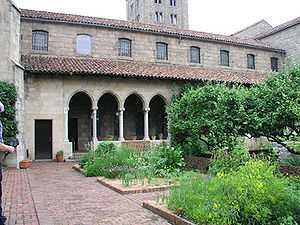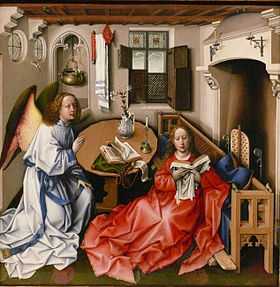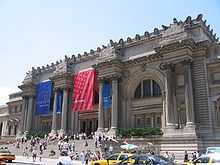The Cloisters
Coordinates: 40°51′53″N 73°55′55″W / 40.86484°N 73.931905°W
| The Cloisters | |
|---|---|
|
from the Hudson River | |
 Location within New York City | |
| Established | May 10, 1938 |
| Location |
99 Margaret Corbin Drive, Fort Tryon Park Manhattan, New York City |
| Coordinates | 40°51′53″N 73°55′55″W / 40.86484°N 73.931905°W |
| Type | Medieval Art |
| Collection size | 1,854 |
| Public transit access |
Bus: M4 to museum's entrance (rush hours only), or M4 or M98 (rush hours only) to the entrance of Fort Tryon Park Subway: 190th Street ( |
| Website | http://www.metmuseum.org/cloisters |
The Cloisters is a museum located in Fort Tryon Park in the Washington Heights section of Upper Manhattan, New York City. It is a branch of the Metropolitan Museum of Art, used to exhibit the museum's extensive collection of art, architecture and artifacts from Medieval Europe.
The Cloisters is situated on a hill overlooking the Hudson River, and incorporates parts from five European abbeys which were disassembled and shipped to New York City, where, between 1934 and 1939, they were reconstructed and integrated together with new buildings in the medieval style designed by Charles Collens. The area around the buildings was landscaped with gardens planted according to horticultural information obtained from medieval manuscripts and artifacts, and the structure includes multiple medieval-style cloistered herb gardens.
The Cloisters was designated a New York City landmark in 1974,[1] and Fort Tryon Park and the Cloisters were listed together as a historic district on the National Register of Historic Places in 1978.
History
The 66.5-acre (26.9 ha) Fort Tryon Park was created by the philanthropist John D. Rockefeller, Jr. beginning in 1917, when he purchased the Billings Estate and other properties in the Fort Washington area and hired Frederick Law Olmsted, Jr., son of one of the designers of Central Park, and the Olmsted Brothers firm to create a park, which he then donated to New York City in 1935. As part of the overall project, Rockefeller also bought the extensive medieval art collection of George Grey Barnard, an American sculptor and collector, who had already established a medieval-art museum near his home in Fort Washington, and gave it to the Metropolitan along with a number of pieces from Rockefeller's own collection, including the Unicorn Tapestries. These became the core of the collection now housed at the Cloisters.
The museum and adjacent gardens within Fort Tryon Park, which incorporate 4 acres (1.6 ha), were created through grants and endowments from Rockefeller, and were built from 1934-39[1][2] Rockefeller also bought and donated several hundred acres of the New Jersey Palisades to the State of New Jersey on the other side of the Hudson River to preserve the view for the museum. This land is now part of the Palisades Interstate Park.
The museum was designed by Charles Collens who incorporated parts from five cloistered abbeys of Catalan, Occitan and French origins. Buildings from Sant Miquel de Cuixà, Sant Guilhèm dau Desèrt, Bonnefont-en-Comminges, Trie-en-Bigòrra, and Froville were disassembled stone-by-stone and shipped to New York City, where they were reconstructed and integrated by Collens into a cohesive whole by simplifying and merging the various medieval styles in his new buildings.
In 1988, the Treasury Gallery within The Cloisters, containing objects used for liturgical celebrations, personal devotions, and secular uses, was renovated. Other galleries were refurbished in 1999.
Collection
The Cloisters collection contains approximately five thousand European medieval works of art, with a particular emphasis on pieces dating from the 12th through the 15th centuries. Notable works of architecture include the Cuixà cloister, with an adjacent Chapter House; and the Fuentidueña Apse from a chapel in the province of Segovia (Castilla y León, Spain).
Among the works of art are seven Flemish tapestries depicting The Hunt of the Unicorn,[3] Robert Campin's Mérode Altarpiece,[4] and the Romanesque altar cross known as the Cloisters Cross or Bury St. Edmunds Cross, which was acquired under the curatorship of Thomas Hoving.
The Cloisters also holds many medieval manuscripts and illuminated books, including the Limbourg brothers' Les Belles Heures du Duc de Berry and Jean Pucelle's book of hours for Jeanne d'Evreux.
Library and Archives
The Cloisters Library is one of the Metropolitan Museum's thirteen libraries. It contains 15,000 volumes of books. The Library and Archives contains Museum Administration papers, the personal papers of George Grey Barnard, early glass lantern slides of museum materials, curatorial papers, museum dealer records, scholars records, recordings of musical performances at the museum, and maps.[5]
Gallery
-

A view from the south
-

The building's tower
-

The garden
-

One of the Hunt of the Unicorn tapestries
-

The center panel of the Merode Altarpiece triptych
-

"Storing Up Manna" (1497–99)
-

"Procession of Flagellants" from Belles Heures of Jean of France, Duke of Berry
-

French Late Gothic Virgin and Child, 14th century, from Cernay-lès-Reims
In popular culture
- 1948 – In the film Portrait of Jennie, starring Joseph Cotten, Jennifer Jones and Ethel Barrymore, the Cloisters in Fort Tryon Park was used as the location for a convent school.[6]
- 1968 – Two scenes in Coogan's Bluff, starring Clint Eastwood, were filmed in Fort Tryon Park, including a shoot-out at the Cloisters and a motorcycle chase in the Heather Garden.[6]
See also
- List of museums and cultural institutions in New York City
- List of New York City Landmarks
- National Register of Historic Places listings in New York County, New York
- Paintings from Arlanza
References
Notes
- ↑ 1.0 1.1 New York City Landmarks Preservation Commission; Postal, Matthew A. (ed. and text); Dolkart, Andrew S. (text). (2009) Guide to New York City Landmarks (4th ed.) New York: John Wiley & Sons. ISBN 978-0-470-28963-1, p.213
- ↑ "The Cloisters Museum and Gardens". The Metropolitan Museum of Art.
- ↑ "Gallery 017 – Unicorn Tapestry Hall (The Cloisters)". The Metropolitan Museum of Art.
- ↑ for example by Campbell in: National Gallery Catalogues (new series): The Fifteenth Century Netherlandish Paintings, p. 72, Lorne Campbell, 1998, ISBN 1-85709-171-X and his 1974 Burlington article JSTOR specifically dealing with the authorship of the work
- ↑ "The Cloisters Library and Archives" on the Metropolitan Museum of Art website
- ↑ 6.0 6.1 "The Cloisters in Popular Culture: "Time in This Place Does Not Obey an Order"". metmuseum.org.
Further reading
- Barnet, Peter; Wu, Nancy (2005). The Cloisters: Medieval Art and Architecture. New York: The Metropolitan Museum of Art. p. 208. ISBN 1-58839-176-0.
- Hoving, Thomas. King of the Confessors. Simon & Schuster. New York, New York: 1981.
- Hoving, Thomas. King of the Confessors: A New Appraisal. cybereditions.com. Christchurch, New Zealand: 2001.
- Rorimer, James J., The Cloisters. The Building and the Collection of Mediaeval Art in Fort Tryon Park, 11th edition, New York 1951.
- Uzig, Nicholas M. "(Re)casting the Past: The Cloisters and Medievalism," The Year's Work in Medievalism 27 (2012).
External links
| Wikimedia Commons has media related to The Cloisters. |
- "Visit The Cloisters". The Metropolitan Museum of Art.
- "Medieval Art and The Cloisters". The Metropolitan Museum of Art.
- Cloisters Archives Collection from the Digital Collections from The Metropolitan Museum of Art Libraries
- Guide to The Cloisters—About.com
- Planning a Visit to The Cloisters
- The Cloisters' 75th Anniversary Samantha Dossena, L'Idea Magazine N.4, 2013



